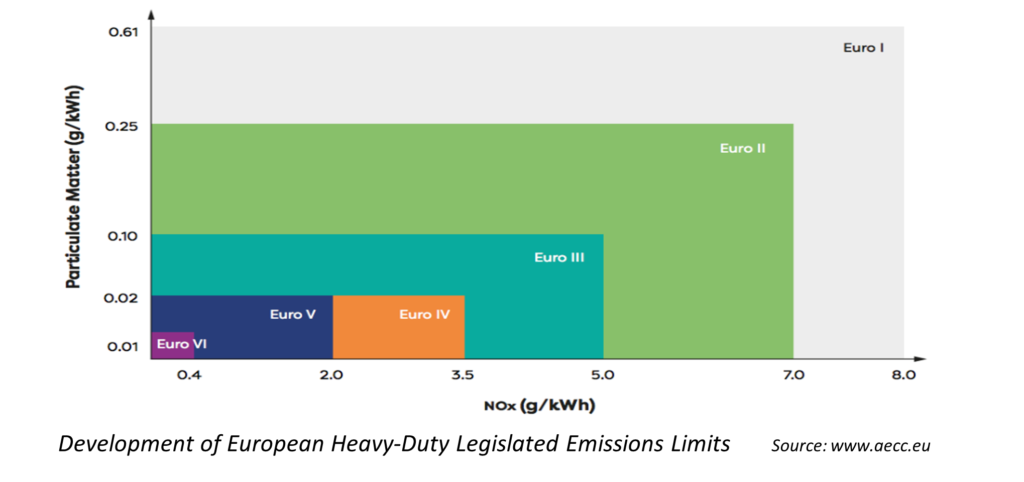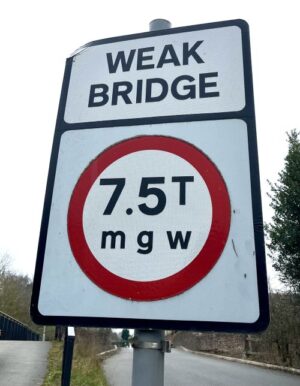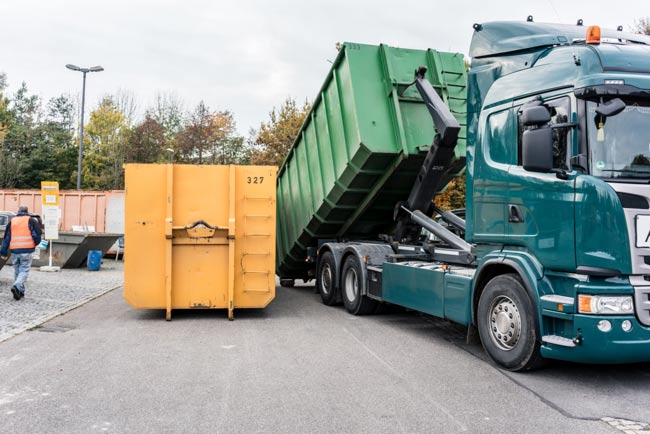- Heavy Duty Emission Standards – a brief history
- What are the testing procedures in Euro VI?
- Why do we refer to Euro VI and not Euro 6?
- What does the E refer to in Euro VI-E?
- So what is Euro VI-E all about and how does it apply to me?
- Will there be a Euro VII?
- What is Euro VII (Euro 7) likely to mean?
- Frequently Asked Questions
Euro VI emission standards, the latest and most stringent standard for vehicle emissions currently in place, were introduced by the European Commission in January 2013 for new vehicles and 2014 for all registrations. They are the latest and most stringent emissions standards that must be met by HGVs on Europe’s roads.
The protection of the environment, specifically of air quality and the reduction of greenhouse gas emissions has long been a priority for the European Commission. Developments in technological solutions to help further protect the environment and reduce air pollution are encouraged by the commission, and is reflected in the introduction of and continually raised standards expected within HGV and all vehicle emissions.
Heavy Duty Emission Standards – a brief history
First introduced in 1992, the European Commission has imposed increasingly strict limits on vehicle emissions for heavy-goods vehicles. These limits are known as Euro standards and refer to acceptable limits of engine emissions.

Euro I, II and III all led to healthy improvements in engine emission levels, but catalytic emission control technologies were only required with the introduction of Euro IV & V in 2005 and 2008 respectively.
Since the introduction of the Euro standards, nitrous oxide (NOx) limits for heavy-duty engines have been reduced by 95%, and the limits for particulates (PM) have been reduced by 97%.

This timeline illustrates the implementation of Euro standards over recent years and indicates that a new standard, Euro VII will be introduced in 2025, but more on that later.
What are the testing procedures in Euro VI?
Euro VI saw the adjustment of emission limits, an extension to durability provisions and also introduced several new elements to the emission standard, including:
- New transient and stationary duty cycles – the World Harmonised Transient Cycle (WHTC), and the World Harmonised Stationary Cycle (WHSC).
- PN (particulate number) measuring and emission limits
- New testing requirements, including off-cycle, or laboratory-based testing
- Stricter OBD requirements
- Ammonia (NHᶾ) concentration limits
- In service conformity (ISC) on-road portable emissions (PEMS) testing, which is conducted over a mix of urban, rural and motorway conditions
For further information about testing requirements for Euro VI-E visit https://www.transportpolicy.net/standard/eu-heavy-duty-emissions/
Why do we refer to Euro VI and not Euro 6?
In order to avoid confusion, all European emission standards for heavy-duty vehicles, such as lorries/HGVs and buses, are commonly referred to with roman numerals e.g. Euro VI. Numbers are typically used for light-duty vehicles such as cars and vans, and will appear as Euro 6, for example.
In some cases, the word Euro is written in block capitals for heavy-duty vehicles (e.g. EURO VI) and in sentence case for light-duty vehicles (e.g. Euro 6).
What does the E refer to in Euro VI-E?
Within each level of heavy-duty emission standards there have been several phased implementations of additional requirements that must be achieved in order to comply. These phased steps are denoted in alphabetical order and have charted the development of the emission standard from Euro VI-A through to Euro VI-E, as illustrated below.

Euro VI-E was introduced for new vehicles in September 2020 and all new registrations have had to comply since September 2021.
So what is Euro VI-E all about and how does it apply to me?
The main difference that Euro VI-E has introduced to vehicle emission standards is the measurement of the Particulate Number (PN) during the on-road test and the inclusion of cold-start emissions. In addition stricter on-board diagnostic requirements are now measured, along with off-cycle testing.
The in-data evaluation of PEMS (Portable Emissions Measurement Systems) has also been introduced. This measures emissions from combustion engines whilst the vehicle is being used therefore enabling real-time in use testing. This is an excellent method of measuring the impact of emissions from combustion engines on the environment.
Will there be a Euro VII?
Well, the short answer is yes. It is widely anticipated that an announcement will be expected soon from the European Commission regarding the introduction of the next stage of emission standards. These will be called Euro VII for heavy-duty vehicles, and Euro 7 for light-duty vehicles.
In post-Brexit Britain it is unlikely that we will see any changes to the regulations imposed on emissions standards. Britain’s own unilateral Climate Change Act actually imposes even tougher requirements than the EU for tackling climate change through reduced carbon emissions.
What is Euro VII (Euro 7) likely to mean?
We anticipate that further restrictions on emissions will be introduced in Euro VII in order to drive towards zero-emission mobility goals. It should be noted that due to a simplification of the regulations, the final emissions standard will be known as Euro 7 as it will apply to all vehicles.
It is likely that this will be achieved through the innovative development of advanced emission control technologies for vehicles with internal combustion engines.
The Association for Emissions Control by Catalyst (AECC) predicts that despite growing numbers of electric and hybrid vehicles (especially within the light-duty vehicle category), internal combustion engines will continue to power the majority of vehicles in the medium term.
They go on to suggest that the standards set out in Euro 7 will present an ideal opportunity to force all vehicles to become truly clean and efficient through continued innovation.

We now know that Euro 7 will, for the first time, include non-exhaust emissions, a measure which will affect all vehicles.
Watch this space…
Frequently Asked Questions
What is the Euro VI-E emissions standard?
Euro VI-E is the latest and most stringent emissions standard that must be met by HGVs using Europe’s roads.
Why have the emissions standards got more strict?
With rising global temperatures and threats posed by global warming the European Commission has developed an increasingly strict set of rules to control engine emissions, including HGV emissions. The aim is to slow reduce the output of greenhouse gases and protect the environment.
Is Euro VI-E the last emissions standard?
No, the Euro 7 emissions standard will be enforced in full for new heavy duty vehicles in 2029. Older vehicles will still be able to run for many years in to the late 2030s without any issues. Further information about Euro 7 is available in our news article here.




